Registered marriages up by 25 percent in 2021
A total of 41,025 marriages were registered in the National Capital Region (NCR), an increase of 25.5 percent from the total marriages of 32,689 in 2020. This increase may have been brought about by the continued easing of quarantine measures due to the Coronavirus disease 2019 (COVID-19) pandemic. However, there was a 39.9 percent decrease in the number of registered marriages in the past ten years from 68,210 in 2012 to 41,025 in 2021. (Figure 1 and Tables 1 and 3)
Concurrently, the crude marriage rate (CMR)1 increased to 2.9 or 3 marriages per thousand population from 2.4 marriages per thousand population in 2020. On average, a total of 112 marriages were solemnized daily.
1Population estimate used was taken from the updated population projections based on the 2015 Census of Population available at www.psa.gov.ph/statistics/census/projected-population.
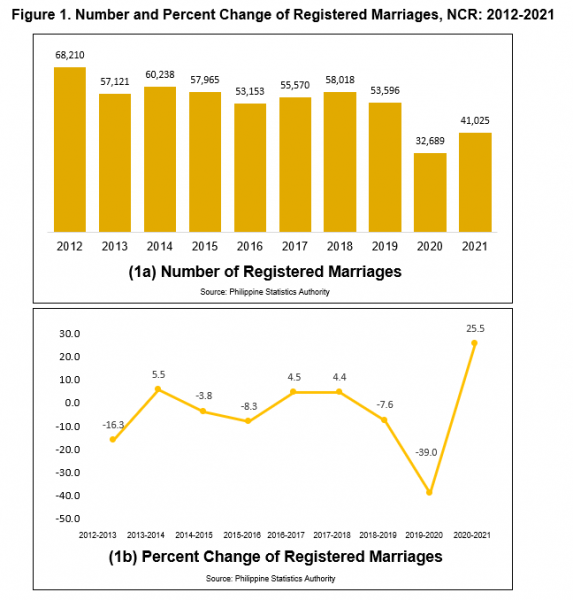
Registered Marriages are highest in Quezon City
Among the 16 cities and a municipality in NCR, Quezon City recorded the highest number of registered marriages with 13,200 or 32.2 percent of total marriages. Two more cities with a relatively large population recorded a high number of registered marriages. The City of Manila recorded the second highest number of marriages with 7,899 (19.3% share) followed by the City of Caloocan with 3,780 (9.2% share). These three cities collectively shared almost two-thirds (60.7%) of the total registered marriages in NCR. The same cities also reported the highest number of marriages in 2020.
On the other hand, the municipality of Pateros had the lowest number of registered marriages with only 182 or 0.4 percent of the total marriages in NCR.
Meanwhile, the highest increase in registered marriages was observed in Quezon City and the City of Las Piñas with 40.1 percent, from 9,420 and 1,294 in 2020 to 13,200 and 1,813 in 2021 respectively. A decrease of 9.2 percent was recorded in The City of Caloocan, from 4,165 in 2020 to 3,780 in 2021. (Figure 2 and Table 2)
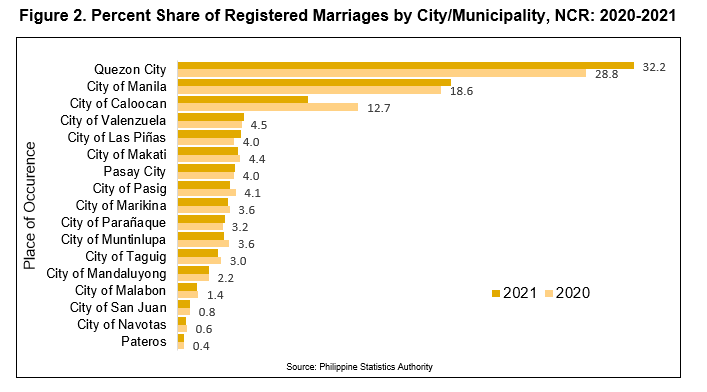
Most marriages occurred in December
In 2021, registered marriages occurred the most in December with 6,639 (16.2% share). On the other hand, the month of August had the least number of registered marriages with 1,189 (2.9% share). (Figure 3 and Table 3)
In terms of daily average, the months of February, June, October, November, and December recorded higher daily averages compared to the region’s average of 112.
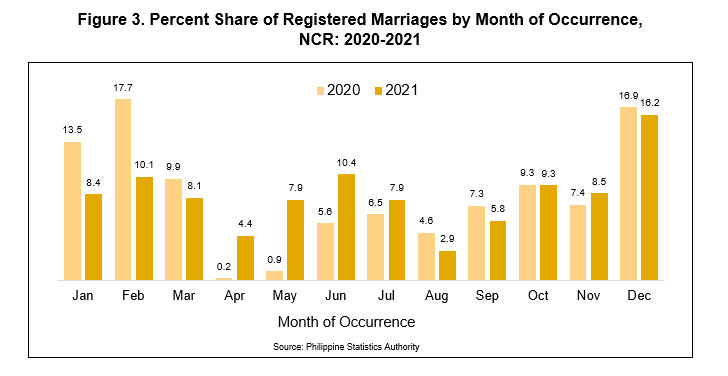
Majority of couples married between the ages of 25 to 29 years
Of the total number of registered marriages in the region, about one in every four involved males and females were aged 25 to 29 (9,292 or 22.6% share). Around three in ten men (14,276 or 34.8% share) and four in ten women (16,916 or 41.2% share) married at these ages. In 2021, the median age of marriage was 29 years old for women and 30 years old for men. Registered marriages between adolescent males and females account for 30 or 0.1 percent of the total marriages in the region. Two recorded marriages were between men aged 60 and over and women aged 15 to 19. (Tables 4 and 5)

Most marriages between Filipinos and non-Filipinos involved American, Indian, and Chinese nationals
There were 38,782 (94.5% share) registered marriages between Filipino men and women, while 2,095 (5.1% share) registered marriages were between Filipinos and foreign nationals. Among intermarriages with foreign nationals, a total of 1,903 (90.8% share) Filipino women married non-Filipino men, while 192 (9.2% share) Filipino men married women of foreign nationals. The other 143 marriages involved foreign nationals, while the remaining 5 marriages lacked sufficient information about the citizenship of the male or female spouses. (Tables 6a and 6b)
About one in four marriages were between Filipinos and American nationals (571 or 27.3% share). Filipino-Indian and Filipino-Chinese marriages accounted for 15.5 percent (325) and 12.2 percent (255), respectively.
Most Filipino females in intermarriages were married to American nationals (27.5% share), followed by Indian (16.9% share) and Chinese (11.6% share) nationals. On the other hand, one in four Filipino males married American (25% share) nationals, while 18.2 and 12.5 percent married Chinese and Canadian nationals, respectively. (Figures 5a and 5b, and Table 6b)

Marriages contracted through a civil ceremony decreased by half in 2021
Of the total registered marriages in 2021, 26,642 or 64.9 percent were performed in other religious rites. About one-third (13,972 or 34.1% share) was officiated through civil ceremony and in the Roman Catholic church. A decrease of 50.4 percent of marriages contracted through a civil ceremony was recorded, from 14,105 in 2020 to 6,990 in 2021. (Figure 6 and Table 7)
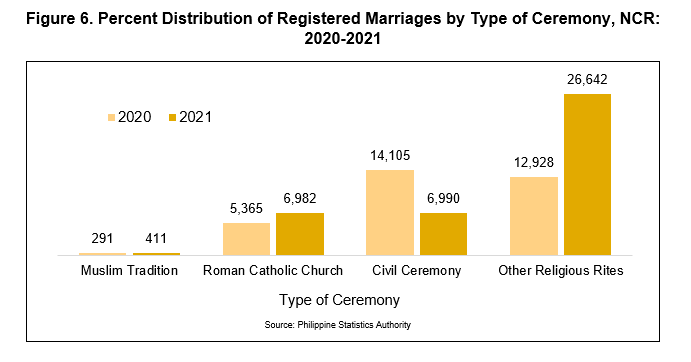
About 96 percent were registered on time
Timely registration refers to the registration of marriage within 15 days following the solemnization of the marriage while in marriages exempt from license requirement, the prescribed period is 30 days, at the place where the marriage was solemnized. In 2021, 96.0 percent of marriages were registered on time while 4.0 percent were registered late. The Cities of Manila and Muntinlupa recorded the highest percentage of timely registration with 99.5 percent while Quezon City recorded the lowest percentage with 91.0 percent.
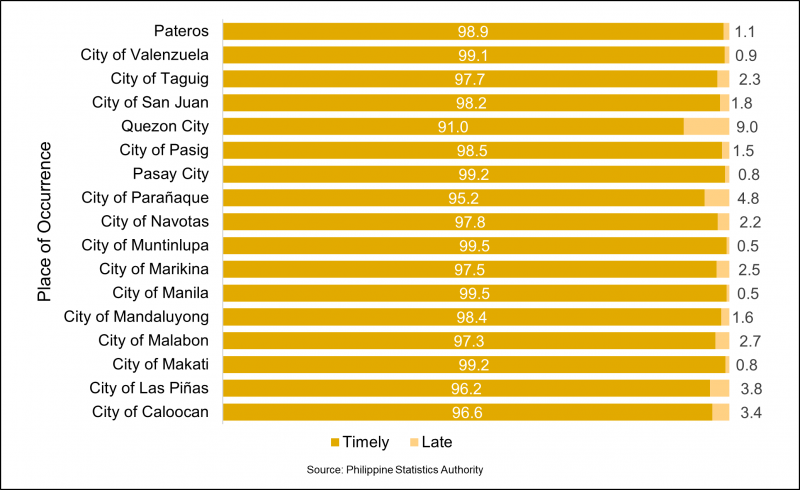
SGD.
PACIANO B. DIZON
Regional Director
Technical Notes
Vital statistics are derived from information obtained at the time when the occurrences of vital events and their characteristics are inscribed in a civil register.
Vital acts and events are the births, deaths, fetal deaths, marriages, and all such events that have something to do with an individual’s entrance and departure from life together with the changes in civil status that may occur to a person during his lifetime. Recording of these events in the civil register is known as vital or civil registration and the resulting documents are called vital records.
Marriage is a special contract of permanent union between a man and a woman entered in accordance with law for the establishment of conjugal and family life. It is the foundation of the family and an inviolable social institution whose nature, consequences, and incidence are governed by law and not subject to stipulation, except that marriage settlements may fix the property relations during the marriage within the limits provided in the Family Code of the Philippines.
Crude Marriage Rate (CMR) refers to the number of marriages per 1,000 mid-year population.
Marital (Legitimate) children conceived or born during the marriage of the parents. Children born after one hundred and eighty days following the celebration of the marriage, and before three hundred days following its dissolution or the separation of the spouses shall be presumed to be legitimate. (Art. 225, Civil of the Philippines).
Nonmarital (Illegitimate) children conceived and born out of a valid marriage unless otherwise provided in the Family Code (Art. 165, F.C.).
Attachments:
- Table 1. Number and Percent Change of Registered Marriages, National Capital Region: 2012-2021
